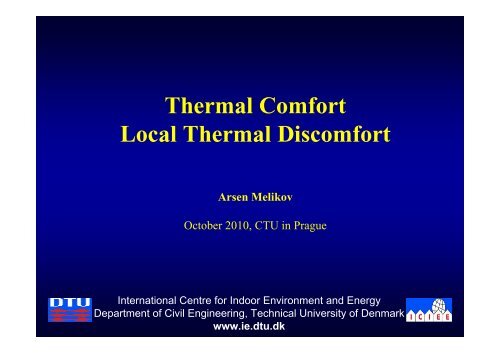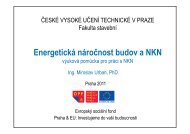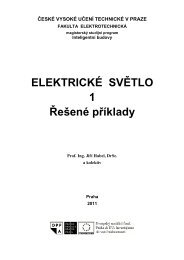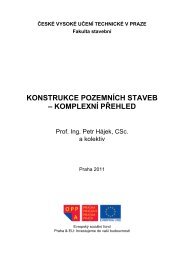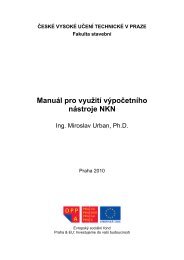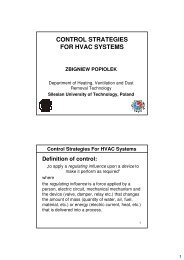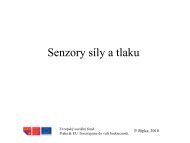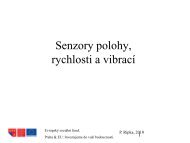Thermal Comfort Local Thermal Discomfort
Thermal Comfort Local Thermal Discomfort
Thermal Comfort Local Thermal Discomfort
- No tags were found...
Create successful ePaper yourself
Turn your PDF publications into a flip-book with our unique Google optimized e-Paper software.
<strong>Thermal</strong> <strong>Comfort</strong><br />
<strong>Local</strong> <strong>Thermal</strong> <strong>Discomfort</strong><br />
Arsen Melikov<br />
October 2010, CTU in Prague<br />
International Centre for Indoor Environment and Energy<br />
Department of Civil Engineering, Technical University of Denmark<br />
www.ie.dtu.dk<br />
1
<strong>Thermal</strong> <strong>Comfort</strong><br />
Human thermal comfort is defined by ASHRAE<br />
as the state of mind that expresses satisfaction<br />
with the surrounding environment.<br />
Maintaining thermal comfort for occupants of<br />
buildings or other enclosures is one of the<br />
important goals of HVAC design engineers<br />
2
Factors for <strong>Thermal</strong> <strong>Comfort</strong><br />
• Environmental parameters<br />
- air temperature (essential factor)<br />
- mean radiant temperature (important)<br />
- air velocity (important)<br />
- relative humidity (relatively small effect)<br />
• Personal variables<br />
- activity level<br />
- clothing insulation<br />
• Secondary factors<br />
- non-uniformity of the environment<br />
- adaptation<br />
-age<br />
- outdoor climate<br />
-etc.<br />
3
Conditions for <strong>Thermal</strong> <strong>Comfort</strong><br />
• Environmental parameters<br />
- air temperature (essential factor)<br />
- mean radiant temperature (important)<br />
- air velocity (important)<br />
- relative humidity (relatively small effect)<br />
• Personal variables<br />
- activity level<br />
- clothing insulation<br />
• Secondary factors<br />
- non-uniformity of the environment<br />
- adaptation<br />
-age<br />
- outdoor climate<br />
-etc.<br />
4
<strong>Thermal</strong> comfort<br />
• General thermal comfort:<br />
- Summer temperature range<br />
- Winter temperature range<br />
• <strong>Local</strong> thermal discomfort:<br />
- Draught<br />
- Vertical temperature difference<br />
- Radiant asymmetry<br />
- Cold/warm floor<br />
5
<strong>Local</strong> <strong>Thermal</strong> <strong>Discomfort</strong><br />
• Asymmetric <strong>Thermal</strong> Radiation<br />
Caused by cold windows, uninsulated walls, cold products,<br />
cool or warm machinery, heated or cold ceiling, etc.<br />
6
<strong>Local</strong> <strong>Thermal</strong> <strong>Discomfort</strong><br />
• Asymmetric <strong>Thermal</strong> Radiation<br />
Requirements in standards and guidelines<br />
DISSATISFIED<br />
%<br />
80<br />
60<br />
40<br />
20<br />
10<br />
86<br />
4<br />
LOCAL DISCOMFORT CAUSED BY RADIANT<br />
TEMPERATURE ASYMMETRY<br />
WARM CEILING<br />
COOL WALL<br />
COOL CEILING<br />
WARM WALL<br />
2<br />
1<br />
0 5 10 15 20 25 30 35 o C<br />
RADIANT TEMPERATURE ASYMMETRY<br />
7
<strong>Local</strong> <strong>Thermal</strong> <strong>Discomfort</strong><br />
• Vertical Air Temperature Difference<br />
Vertical temperature difference may cause warm discomfort at<br />
the head and cold discomfort at the feet. May occur in rooms with<br />
displacement ventilation, etc.<br />
8
<strong>Local</strong> <strong>Thermal</strong> <strong>Discomfort</strong><br />
• Vertical Air Temperature Difference<br />
Requirements in standards and guidelines<br />
9
<strong>Local</strong> <strong>Thermal</strong> <strong>Discomfort</strong><br />
• Warm or Cold Floors<br />
<strong>Discomfort</strong> due to direct contact between the feet and floor with a<br />
too high or too-low surface temperature. Important for people with<br />
bare feet.<br />
To save energy, floor materials with a low contact coefficient (cork,<br />
wood, carpets), floor heating systems can be used to eliminate the<br />
desire for higher ambient temperatures caused by cold feet.<br />
Textiles 21 to 28˚C<br />
Oak floor 24.5 to 28˚C<br />
Concrete 26 to 28.5˚C<br />
10
<strong>Local</strong> <strong>Thermal</strong> <strong>Discomfort</strong><br />
• Warm or Cold Floors<br />
Requirements in standards and guidelines<br />
DISSATISFIED<br />
%<br />
80<br />
60<br />
40<br />
20<br />
10<br />
86<br />
4<br />
LOCAL DISCOMFORT CAUSED BY<br />
WARM AND COOL FLOORS<br />
2<br />
1<br />
5 10 15 20 25 30 35 40<br />
FLOOR TEMPERATURE<br />
o C<br />
11
<strong>Local</strong> <strong>Thermal</strong> <strong>Discomfort</strong><br />
• Draught<br />
Undesired local cooling of the body caused by air movement.<br />
Serious problem in buildings and vehicles<br />
Leads to demand for higher air temperatures in rooms and thus<br />
use of more energy<br />
May cause people to stop ventilation systems which leads to<br />
decreased perceived indoor air quality, health effects and<br />
decrease performance of occupants<br />
12
<strong>Local</strong> <strong>Thermal</strong> <strong>Discomfort</strong><br />
• Airflow characteristics in rooms<br />
13
<strong>Local</strong> <strong>Thermal</strong> <strong>Discomfort</strong><br />
• Airflow characteristics in rooms<br />
Turbulence intensity<br />
Air Velocity(m/s)<br />
0,4<br />
0,3<br />
0,2<br />
0,1<br />
Vm=0.14 m/s Tu=71%<br />
Vm=0.139 m/s Tu=36%<br />
Vm=0.126 m/s Tu=6.6%<br />
0<br />
10 12 14 16 18 20 22<br />
Time(s)<br />
14
<strong>Local</strong> <strong>Thermal</strong> <strong>Discomfort</strong><br />
Frequency of velocity flutuations<br />
15
<strong>Local</strong> <strong>Thermal</strong> <strong>Discomfort</strong><br />
Frequency of velocity flutuations<br />
16
<strong>Local</strong> <strong>Thermal</strong> <strong>Discomfort</strong><br />
• Equivalent frequency<br />
The equivalent frequency, f e , of a randomly fluctuating velocity is<br />
defined as the frequency of sinusoidal velocity fluctuations with<br />
the same ratio of the standard deviation of acceleration to the<br />
standard deviation of air velocity as in the random velocity<br />
fluctuations. It is an integral measure for the frequency of the<br />
velocity fluctuations of a turbulent flow.<br />
0,3<br />
f<br />
e<br />
=<br />
1<br />
2π<br />
⋅<br />
SD<br />
SD<br />
a<br />
v<br />
Air Velocity (m/s)<br />
0,2<br />
0,1<br />
a = ΔV/Δτ s<br />
ΔV<br />
Δτ s<br />
0<br />
15 17 19 21 23 25<br />
Time(s)<br />
17
<strong>Local</strong> <strong>Thermal</strong> <strong>Discomfort</strong><br />
• Factors affecting draught<br />
- air temperature<br />
- mean velocity<br />
- turbulence intensity<br />
- airflow direction<br />
- frequency of velocity fluctuation<br />
- person’s general thermal sensation<br />
18
<strong>Local</strong> <strong>Thermal</strong> <strong>Discomfort</strong><br />
• Draught Rating Model<br />
PD = (34 – t a )(v – 0.05) 0.62 (0.37vTu + 3.14)<br />
For v < 0.5 m/s insert v = 0.05 m/s;<br />
for PD > 100%, insert PD = 100%<br />
Valid for: 20 < t a < 26˚C, v < 0.05 m/s<br />
19
<strong>Local</strong> <strong>Thermal</strong> <strong>Discomfort</strong><br />
Impact of general thermal sensation on draught discomfort<br />
20
<strong>Local</strong> <strong>Thermal</strong> <strong>Discomfort</strong><br />
Impact of airflow direction on draught discomfort<br />
21
<strong>Local</strong> <strong>Thermal</strong> <strong>Discomfort</strong><br />
Impact of airflow direction on draught discomfort<br />
22
<strong>Local</strong> <strong>Thermal</strong> <strong>Discomfort</strong><br />
Impact of velocity flutuations on draught discomfort<br />
Human subjects exposed to periodial velocity fluctuations<br />
at the same mean velocity and air temperature<br />
23
<strong>Local</strong> <strong>Thermal</strong> <strong>Discomfort</strong><br />
Impact of equivalent frequency draught discomfort<br />
DISSATISFIED (%)<br />
40<br />
30<br />
20<br />
10<br />
Mean Velocity<br />
0.1 m/s<br />
0.2 m/s<br />
0.3 m/s<br />
T a =20C, T u ~35%<br />
0<br />
0 0,2 0,4 0,6 0,8 1 1,2<br />
EQUIVALENT FREQUENCY (Hz)<br />
24


